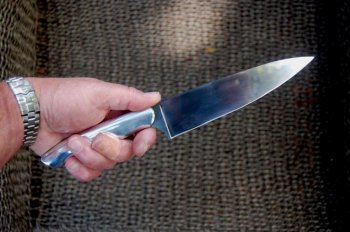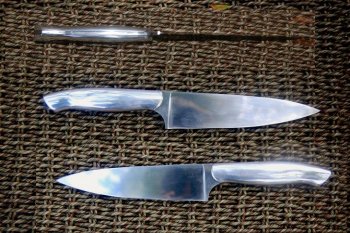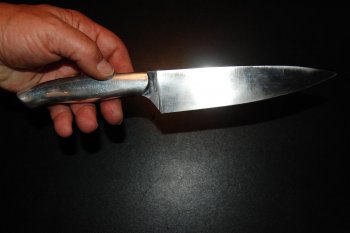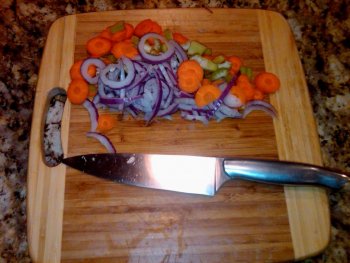Happy to help! As far as balance goes, that sounds good but it hard to say in an educated way without holding the knife and judging the whole weight of the knife. Light knives have become pretty popular recently but I still like heavier knives when it comes to a western chef, that's all personal preference. The best way to tell is to use it, since you stated earlier that you don't use kitchen knives much I'll walk through some common techniques for that style. The chef is the work horse of a kitchen and used for most tasks, but the design is specialized for chopping and mincing using the curve towards the tip of the knife as a fulcrum in constant contact with the board. It will help you a lot in your design and manufacture if you learn how to use them well. I typically hold a knife in my left hand so adjust to suit your preference. Starting with a peeled onion cut in half root to sprout and place the flat side on a board. Position the knife so that the onion is at the heal end of the knife and the curve at the tip is in contact with the board. Bring the knife down in a smooth motion to take a slice off off the onion keeping the front of the knife in contact with the board. Move the onion not the knife to continue. The knife will have a bit of an oscillating motion as the heal comes down and don't raise the knife completely off the board. Try to think of it as one of those big paper trimmers they had in school with a solid pivot bolt. Once you've got slices rotate the slices so that you can cut across the rings and continue until you have an even dice. For the mincing action take some of the chopped onion and place in a small pile on your board. Grasp your knife and hold edge down in the center of the pile. Take your other hand and put it on the spine above the curve that will act as a fulcrum. Bring the heal of the knife up and down while moving the heal across the food. The tip stays put with your other hand holding it down using gentle pressure. Be sure to keep the fingers of the hand on the spine up and away. When you're used to the motion it can be done very rapidly and with a good knife will process food to a very fine mince. The same motion is used commonly to process fresh herbs. I'll see if I can't find a video to illustrate later.
Once you have some practice you'll be able to tell right away if your balance is right, and the precision and efficiency of your bevels in use. Practice with whatever commercial chef you have in the house, when you're comfortable get the knife you made. Ask yourself if it is easier or harder to keep on the board. Is the cutting action more difficult to control? These will tell you what you need to know about balance, edge bevel, and blade thickness.








